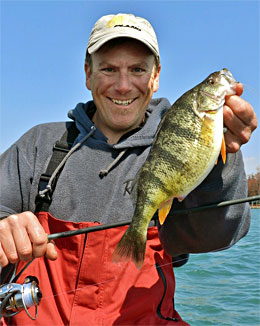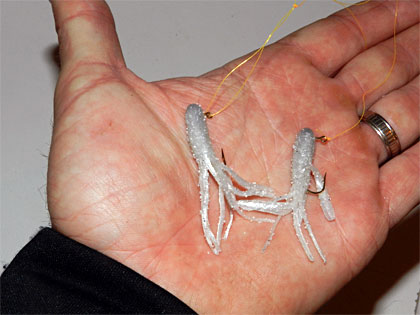

By Jeff Nedwick on Dec 19, 2013 with Comments 0
Predicting the start of the ice fishing season on Lake St. Clair used to be fairly easy. Ice typically began forming on canals and marinas shortly after Thanksgiving and by the New Year, safe ice usually covered much of the lake.
However, the inconsistent winter weather of the past several years has made it difficult to predict when – or even if – the ice fishing season will begin. More often than not, about the time safe ice starts to form, warm weather moves in, resulting in an extended period of patchy ice cover and lots of open water – a virtual perch fishing purgatory that frustrates ice anglers.
But these in-between ice conditions also provide new perch fishing opportunities for anglers willing to make the necessary adjustments.

Open water opportunities abound for jumbo Lake St. Clair perch even if ice fishing isn’t an option. Photo credit: Millennium Promotions, Inc.
Bass fishing tournament professional, duck hunting guide and lure designer Joe Balog was one of the first to recognize this opportunity and has pioneered a unique approach to winter perch fishing – an approach that starts with an understanding of how perch use ice cover.
Balog’s breakthrough moment came while fishing through skim ice from a dock a few winters ago when he observed a nearby school of aggressive jumbo perch preying on shiners by pinning them to the underside of the ice. The shiners’ inability to elude perch under the ice created a temporary advantage that the perch exploited.
Building upon that experience, Balog repeatedly validated his theory that perch seek out conditions where open water and ice cover intersect – typically in marinas and canal systems in early winter.
While shiners are the main draw, perch also feed opportunistically on prey that’s easier to catch. This may explain why the bellies of big perch that Balog catches from marinas and canals often contain gobies that spend their winters in this relatively stable environment.
This apparent perch – goby connection plays a significant role in presentation and lure selection.
Balog casts 1/32 ounce jigs and plastics on light weight spinning combos and crawls the lure slowly along bottom with a lift and drag retrieve that imitates a slow-moving goby. “Keeping in contact with the bottom is critical”, says Balog. To cover water quickly, he uses an electric trolling motor mounted to the bow of his duck hunting boat.

Another option for selectively targeting large perch that swim below schools of smaller perch is a tandem rig. The top bait must be tied with a loop knot to ensure the lure works properly. Photo credit: Millennium Promotions, Inc.
Generally, he tips his jigs with either two or three inch tube jigs or candy plastics – a local favorite – in natural colors that imitate a goby. Spinning reels are spooled with four to six pound Sufix Performance Ice Braid orange line and paired with a slow to medium action six to eight foot ultralight Daiwa Presso rod that allows him to easily cast light jigs long distances without sacrificing feel.
Feel is also critical when selectively targeting jumbo perch.
With the right gear and experience Balog has demonstrated that it’s possible to differentiate between small and large perch by the way they bite. “Smaller perch will peck or nibble at the plastic jig trailer while the big ones engulf the whole jig and slowly swim off with it, much the way a bass inhales a tube jig in summer”, says Balog.
Balog’s ability to detect the size of a perch simply by the way they bite combined with his ice fishing observations can also be used to trigger bites from larger perch.
While ice fishing Lake St. Clair’s clear, shallow waters, Balog often noted how smaller perch were the first to rush in and bite a jig but were usually too small to inhale the entire bait. After the inevitable “swing and miss” hook set, larger perch lurking on the periphery or below the smaller fish often raced in to inhale the jig as it settled back to the bottom.
This insight quickly found its way into Balog’s open water casting approach.
By deliberately and aggressively ripping the jig away from smaller perch that nibble and peck at the jig’s tail, Balog is able to trigger bites from larger perch attracted to the falling jig that may look like wounded prey.
Perhaps this year will buck recent winter weather patterns and anglers will see a return to a traditional ice fishing season on Lake St. Clair. Even if it does, keep Balog’s near-ice approach in mind for late winter / early spring when big perch will once again exploit the ice – open water connection.
Filed Under: Featured • Ice Fishing Tips • Yellow Perch
About the Author: